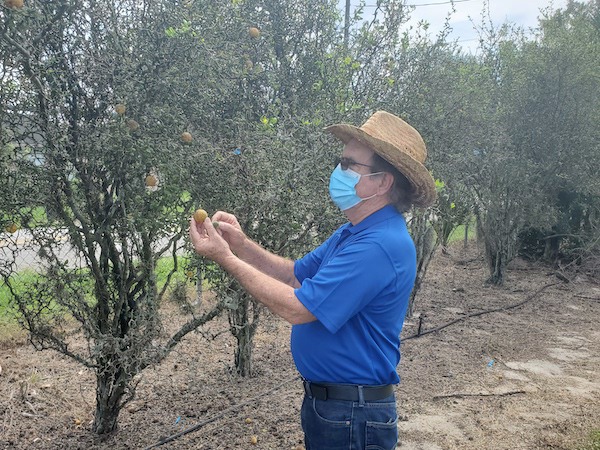University of Florida scientists achieved a major milestone in their quest to develop a citrus greening-resistant tree by sequencing the genome of a fruit plant that’s a close cousin to citrus trees.
The genome sequence is equal to 54,000 pages of copy paper, but within it, scientists believe they’ve found genes to lay the groundwork to make citrus more tolerant and even resistant to certain diseases, including citrus greening.

Dr. Fred Gmitter. Photo credit: Brad Buck, UF/IFAS.
UF/IFAS researchers sequenced the genome from trifoliate orange, in collaboration with scientists from the University of California at Berkeley, the U.S. Department of Energy’s Joint Genome Institute and UF’s Interdisciplinary Center for Biotechnology Research. The new genome will help those who breed new citrus trees that will survive under today’s challenging conditions, including invasive pests, viruses and changing climates.
“Very importantly, trifoliate orange and its hybrids have genes that can confer high tolerance to citrus greening and resistance to the Asian citrus psyllid, the insect that transmits greening to citrus,” said Zhanao Deng, a professor of environmental horticulture and senior author on the new UF/IFAS-led study. “This genome can be used as a reference template to sequence widely used trifoliate orange hybrid rootstock varieties.”
“Most people rarely see trifoliate orange. This is because they usually are the rootstock part of the tree, mostly underground,” said Fred Gmitter, a UF/IFAS professor of citrus breeding genetics and a co-author on the study.
Trifoliate oranges or their hybrids are grown at nurseries, and farmers use them as rootstock to grow the citrus that’s above ground. Trifoliate orange and its hybrids were used as the rootstock for more than three million citrus trees in Florida alone in 2018-2019, UF/IFAS researchers say.
“Because of our high-quality genome, re-sequencing of trifoliate orange hybrid rootstock varieties will be much easier, much quicker and much more cost-efficient,” said Deng. “Re-sequencing will enable development of new breeding tools, such as DNA marker-based selection, genomic selection of new rootstock varieties with resistance and tolerance to citrus greening, citrus tristeza virus and citrus nematodes. The new varieties might give higher yield and fruit quality.”
Citrus breeders want to introduce desirable genes from trifoliate orange into sweet orange, grapefruit and other varieties. It took decades to produce the first citrus scion variety (‘Sun Dragon’) from crossing trifoliate orange and transferring some of its genes across multiple generations into sweet orange. With this new information from genome sequencing, that timeline can be dramatically reduced.
This project was funded by two grants from the Citrus Research and Development Foundation and a grant from the USDA/NIFA Citrus Disease Research and Extension program.
 For more information:
For more information:
Brad Buck
University of Florida
Tel: +1 (813) 757-2224
Email: bradbuck@ufl.edu
www.ifas.ufl.edu
